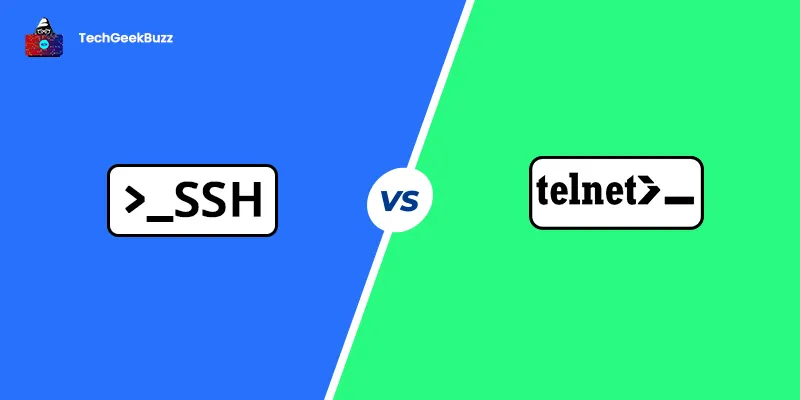Have you ever come across the terms SSH and Telnet? Well, both of them are network protocols for accessing and managing remote systems. Telnet is a TCP/IP protocol that establishes a connection with a remote system via the command line so that it seems like a local system. On the flip side, SSH is a network protocol that accesses and manages remote devices securely over an unsecured network.
Due to the similarities between SSH and Telnet, many individuals get confused between them. While both protocols serve a similar purpose, they have certain differences that you should be aware of.
In this blog post, we shall draw a detailed comparison between SSH and Telnet so that you choose the one that best suits your requirements. Also, we shall walk you through SSH and Telnet, along with their features, advantages, and disadvantages.
So, let us get started!
What is SSH ?
SSH stands for Secure Shell or Secure Socket Shell. It is a cryptographic network protocol that enables users, particularly network administrators, to access a system over unsecured networks. In other words, SSH is a protocol that allows two computer systems to communicate securely over an unsecured network.
The most common applications of SSH are remote login and command-line execution. These applications have a client-server architecture , where an SSH instance connects with the SSH server.
Moreover, SSH works as a layered protocol suite consisting of three different components, as follows:
- Transport Layer: This layer provides server authentication, confidentiality, and integrity.
- User Authentication Protocol: As its name suggests, the user authentication protocol validates the user to the server.
- Connection Protocol : This protocol divides the encrypted tunnel into multiple logical communication channels.
History
A Finnish computer scientist and a researcher at the Helsinki University of Technology, Tatu Ylönen, first designed SSH in 1995. It was the first version (SSH-1). He designed it as a replacement for Telnet and also for unsecured remote Unix shell protocols, such as Berkeley Remote Shell (rsh). Moreover, the password-sniffing attack at his University inspired him to design this network protocol.
At the end of 1995, Tatu Ylönen founded SSH Communications Security to develop SSH. Initially, the SSH software used multiple pieces of free software. However, SSH Communications Security released the later versions of SSH as proprietary software.
Internet Engineering Task Force (IETF) was responsible for the development of version 2 of the SSH protocol. SSH-2 was more secure and included additional features than SSH-1.
Features
The following are the salient features of SSH:
- SSH supports logging in to remote systems without sacrificing security. It keeps usernames, passwords, and other information confidential.
- It supports secure file transfer from one system to another remotely located system.
- This protocol enables system administrators to execute the same commands (running on the local system) on the remote system connected over a network securely.
- SSH automatically creates public and private keys. Both these keys are helpful in authenticating and establishing a communication channel between two remote systems.
Advantages
Here are some notable advantages of SSH:
- SSH is a secure protocol.
- It provides data privacy through public-key encryption.
- SSH authenticates the identity of senders and receivers.
- It protects data from malicious hackers.
Disadvantages
The following are the significant disadvantages of SSH:
- SSH is slower than Telnet.
- It is not capable of protecting data from trojan horses or other viruses.
When to Use SSH?
SSH is a secure network protocol. You can use this protocol whenever you want to connect to remote systems. Moreover, SSH protects user identities, passwords, and other data from unauthorized access and spoofing attacks.
What is Telnet?
Telnet stands for TErminaL NETwork. It is a network protocol that enables you to establish a connection with a remote system in such a way that it seems that you have connected to a local system through the command line. To put it simply, Telnet is a network protocol or software program to access remote computer systems over a network.
In addition, Telnet is used as a TCP/IP protocol for virtual terminal service. Network administrators primarily use telnet to access and manage remote devices. Here, the computer which starts the connection is the local computer, and the other system which accepts the connection is the remote computer.
When the connection between the local and remote computers is established, whatever operations are performed on the remote computer can be seen on the local computer.
History
Telnet was initially developed in 1969. It was standardized as Internet Engineering Task Force (IETF) Internet Standard STD 8. Initially, it was used as an ad hoc protocol with no official definition until March 1973.
Features
Here are the notable features of Telnet:
- Telnet is a client-server application program that allows to set up a connection with remote systems.
- It is a TCP/IP protocol for virtual terminal service.
- After logging in to remote service, Telnet allows users to leverage the services of the remote system and transfer the results back to the local system.
- It uses only one TCP/IP connection.
Advantages
The following are the remarkable upsides of Telnet:
- Telnet is faster than SSH.
- It is a simple protocol.
Disadvantages
Some major drawbacks of Telnet are as follows:
- Telnet is not a secure protocol.
- It transfers data in a plain text format and does not support encrypted data transfer.
- There are no privileges for user authentication.
- It does not support dynamic ports.
When to Use Telnet?
Telnet is not a secure network protocol. Also, it transmits data in plain text. Therefore, it is not used widely today. The following are the two situations where you can opt for Telnet over SSH:
- If a device you are working with does not support SSH.
- When you work on a local area network (LAN) that is not connected to the internet.
SSH vs Telnet - A Detailed Comparison
The following table highlights the key differences between SSH and Telnet:
| SSH | Telnet |
| Secure Shell or Secure Socket Shell is a network protocol that allows you to access a remote system over an unsecured network. | Telnet is a network protocol that enables you to connect with a remote system and make it look like a local system. |
| By default, SSH runs on port number 22. However, you can change this port number. | It runs on port number 23, which is specially designed for local area networks. |
| It is suitable for public networks. | Telnet is ideal for private networks. |
| Since SSH is a secure protocol, it uses public-key encryption for user authentication. | It does not provide any privileges for user authentication. |
| This protocol transfers data in an encrypted format. Therefore, it becomes difficult for attackers to steal and decrypt data. Hence, it provides utmost security over a public network. | Telnet transfers data over a network in a plain text format, including the passwords. |
| Data exchanged between two computer systems using the SSH protocol is less prone to attacks. | Data transferred between two systems using Telnet is prone to malicious attacks. |
SSH vs Telnet - Which is Better?
From the above comparison table, we can conclude that SSH is more secure than Telnet. SSH uses public-key encryption for user authentication, while Telnet does not provide any facility for user authentication. Also, SSH transmits data after encrypting it, whereas Telnet transfers data in plain text.
Choosing SSH over Telnet is ideal because of the security that SSH provides. However, if you are using a device or system that does not support SSH, Telnet is an ideal choice. Moreover, choosing Telnet would be a great move if you use a private network.
Conclusion
Though SSH and Telnet serve a similar purpose of accessing and managing remote systems, SSH is a better choice due to its advanced security measures. Telnet provides very little security, and hence, is rarely in use today. It is primarily used with private networks that require little encryption.
We hope you have got a clear understanding of the differences between SSH and Telnet through this article. You can post your queries in the comments section below if any.
Frequently Asked Questions
1. Why should you use SSH over Telnet?
SSH is more secure than Telnet and serves as a better alternative to Telnet. It protects user identities, passwords, and other data from spoofing attacks. Also, it transfers data in an encrypted format, which is not easy to decrypt. It allows secure file transfer and remote login.
2. Is Telnet faster than SSH?
Yes, Telnet is faster than SSH because it does not involve encryption and key exchange.
3. Why is using Telnet a security risk?
Since Telnet transmits data in the plain-text format, passwords and usernames also get transmitted in plain text. It is vulnerable to identity theft, and hence, using Telnet is a security risk.
4. What are the port numbers for Telnet and SSH?
SSH runs on port number 22, while Telnet runs on 23. You can change the port number of SSH, but you cannot change the port number of Telnet as it does not support dynamic ports.
5. Is Telnet TCP or UDP?
Telnet is purely TCP.
People are also reading:



![What is TCP/IP Model? [Definition, Working, & Layers]](/media/new_post_images/TCP_IP_Model.webp)
